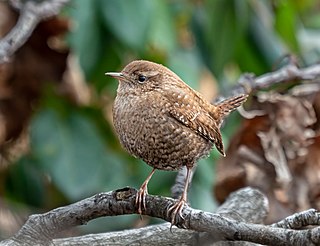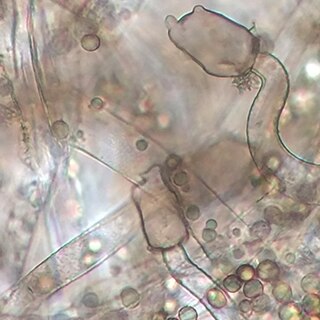
The winter wren is a very small North American bird and a member of the mainly New World wren family Troglodytidae. It was once lumped with the Pacific wren of western North America and the Eurasian wren (Troglodytes troglodytes) of Eurasia under the name winter wren.

Zygomycota, or zygote fungi, is a former division or phylum of the kingdom Fungi. The members are now part of two phyla: the Mucoromycota and Zoopagomycota. Approximately 1060 species are known. They are mostly terrestrial in habitat, living in soil or on decaying plant or animal material. Some are parasites of plants, insects, and small animals, while others form symbiotic relationships with plants. Zygomycete hyphae may be coenocytic, forming septa only where gametes are formed or to wall off dead hyphae. Zygomycota is no longer recognised as it was not believed to be truly monophyletic.

Lacus Hiemalis is a small lunar mare in the Terra Nivium region on the Moon. It is located at 15.0° N, 14.0° E and is 50 km in diameter.

Mucor is a microbial genus of approximately 40 species of molds in the family Mucoraceae. Species are commonly found in soil, digestive systems, plant surfaces, some cheeses like Tomme de Savoie, rotten vegetable matter and iron oxide residue in the biosorption process.
Mucor hiemalis f. silvaticus is a fungal plant pathogen.

Mucor mucedo, commonly known as the common pinmould, is a fungal plant pathogen and member of the phylum Mucoromycota and the genus Mucor. Commonly found on soil, dung, water, plants and moist foods, Mucor mucedo is a saprotrophic fungus found world-wide with 85 known strains. It is often mistaken for Rhizopus rots on fruits due to similar mould growth shape and colour. Contrastingly, however, Mucor mucedo is found to grow on a wide range of stored grains and plants, including cucumber and tomato. Discovered in Italy in 1729 by P.A. Micheli and later noted by Carl Linnaeus in 1753 in the Species Plantarum, Mucor mucedo was originally classified as Mucor vulgaris by Micheli but later classified synonymous under name Mucor mucedo. The species was redescribed as Ascophora mucedo by H.J. Tode in 1790 but this type resided in a stoloniferous habitat and was later made the type of new genus Rhizopus.

Mucor racemosus is a rapidly growing, weedy mould belonging to the division Mucoromycota. It is one of the earliest fungi to be grown in pure culture and was first isolated in 1886. It has a worldwide distribution and colonizes many habitats such as vegetational products, soil and houses. The fungus is mostly known for its ability to exhibit both filamentous and yeast-like morphologies, often referred to as dimorphism. Stark differences are seen in both forms and conditions of the environment heavily affect the phases of the M. racemosus. Like many fungi, it also reproduces both sexually and asexually. The dimorphic capacity of this species has been proposed as an important factor in its pathogenicity and has enhanced the industrial importance. This species is considered an opportunistic pathogen, generally limited to immunocompromised individuals. It also been associated with allergy and inflammations of facial sinuses. Its association with allergy has made it a common fungus used in allergen medical testing. Industrial use of the fungus is in the production of enzymes and the manufacture of certain dairy foods.
Mucor indicus is among the most important members of zygomycetes fungi. This dimorphic fungus is capable of production of several valuable products. Some strains of the fungus have been isolated from the traditional Indonesian food tempeh. M. indicus is nowadays used for production of several homemade food and beverages especially in Asia. This has also been successfully used as a safe nutritional source for fish and rat. The fungus is generally regarded as safe though there are few reports claiming that this is a pathogenic fungus.

Urnula is a genus of cup fungi in the family Sarcosomataceae, circumscribed by Elias Magnus Fries in 1849. The genus contains several species found in Asia, Europe, Greenland, and North America. Sarcosomataceae fungi produce dark-colored, shallow to deep funnel-shaped fruitbodies with or without a stipe, growing in spring. The type species of the genus is Urnula craterium, commonly known as the devil's urn or the gray urn. Urnula species can grow as saprobes or parasites having an anamorphic state. The anamorphic form of U. craterium causes Strumella canker, on oak trees.

Spinellus fusiger, commonly known as bonnet mold, is a species of fungus in the phylum Zygomycota. It is a pin mold that is characterized by erect sporangiophores that are simple in structure, brown or yellowish-brown in color, and with branched aerial filaments that bear the zygospores. It grows as a parasitic mold on mushrooms, including several species from the genera Mycena, including M. haematopus, M. pura, M. epipterygia, M. leptocephala, and various Collybia species, such as C. alkalivirens, C. luteifolia, C. dryophila, and C. butyracea. It has also been found growing on agaric species in Amanita, Gymnopus, and Hygrophorus.
Rhizomucor miehei is a species of fungus. It is commercially used to produce enzymes which can be used to produce a microbial rennet to curd milk and produce cheese.
Epia hiemalis is a moth in the Bombycidae family. It was described by Arthur Gardiner Butler in 1878. It is found in the Amazon region.

Mucor plumbeus is a fungus in the family Mucoraceae that is very common, abundant and distributed worldwide. Mucor plumbeus is not known to be a plant or animal pathogen; however it is able to elicit an immune response in humans by activating the complement system. This species is commonly found in various types of soils over a range of pH, although alkaline soils seem more conducive to its growth. It is also known from the roots of wheat, oat and barley. In addition, M. plumbeus is a common fungal contaminant of indoor built environments. This species shares many similarities with M. racemosus, another fungus that belongs to the family Mucoraceae which is known to cause mucormycosis. Mucor plumbeus is a common spoilage agent of cheese, apples, apple cider and yogurt.
Mucor velutinosus is a fungus first isolated from human clinical specimens in the US. It is closely related to Mucor ramosissimus, but differs in its ability to grow at 37 °C and produce verrucose sporangiospores.
Mucor ellipsoideus is a fungus first isolated from human clinical specimens in the US. M. ellipsoideus is able to grow and sporulate at 37 °C like closely related M. indicus, but the former has narrow ellipsoidal sporangiospores, as compared to the subglobose to ellipsoidal sporangiospores of the latter.
Caladenia hiemalis, commonly known as the dwarf common spider orchid is a species of orchid endemic to the south-west of Western Australia. It has a single, hairy leaf and one or two, cream-coloured flowers with a small, red-striped labellum. It has an early flowering period and its flowering is stimulated by summer fires.
Leucothrix is a genus of large, filamentous bacteria, which live as epiphytes in marine habitats.

Mucor circinelloides is a dimorphic fungus belonging to the Order Mucorales. It has a worldwide distribution, found mostly in soil, dung and root vegetables. This species is described as not known to be able to produce mycotoxins, however it has been frequently reported to infect animals such as cattle and swine, as well as fowl, platypus and occasionally humans. Ketoacidotic patients are particularly at risk for infection by M. circinelloides.
Thelymitra hiemalis, commonly called the winter sun orchid, is a species of orchid that is endemic to Victoria. It is a winter flowering orchid with greenish sepals and blue or mauve petals with large, irregular, darker spots.








